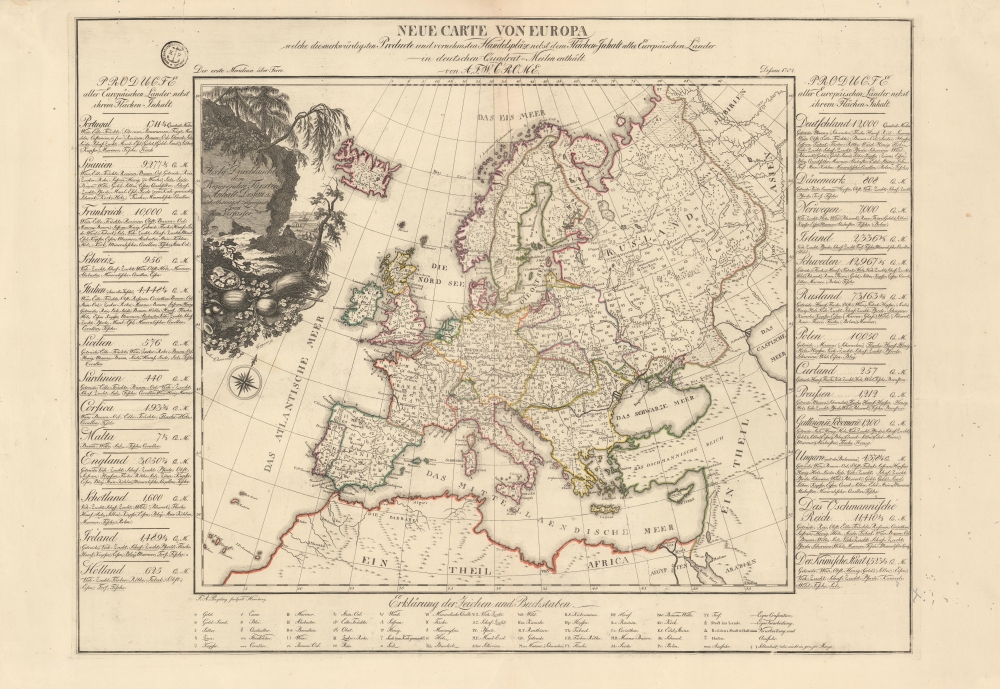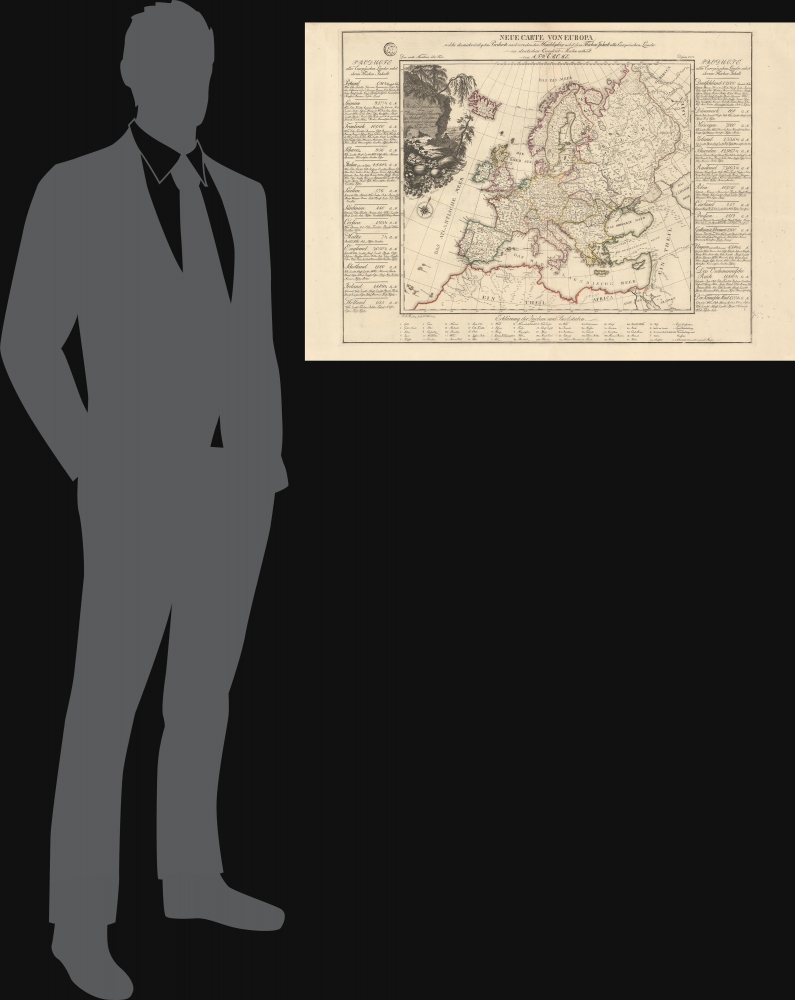Digital Image: 1782 Crome Map of Europe: First Economic Map of Europe
EuropeEconomical-crome-1782_d
Description
FOR THE ORIGINAL ANTIQUE MAP, WITH HISTORICAL ANALYSIS, CLICK HERE.
Digital Map Information
Geographicus maintains an archive of high-resolution rare map scans. We scan our maps at 300 DPI or higher, with newer images being 600 DPI, (either TIFF or JPEG, depending on when the scan was done) which is most cases in suitable for enlargement and printing.
Delivery
Once you purchase our digital scan service, you will receive a download link via email - usually within seconds. Digital orders are delivered as ZIP files, an industry standard file compression protocol that any computer should be able to unpack. Some of our files are very large, and can take some time to download. Most files are saved into your computer's 'Downloads' folder. All delivery is electronic. No physical product is shipped.
Credit and Scope of Use
You can use your digial image any way you want! Our digital images are unrestricted by copyright and can be used, modified, and published freely. The textual description that accompanies the original antique map is not included in the sale of digital images and remains protected by copyright. That said, we put significant care and effort into scanning and editing these maps, and we’d appreciate a credit when possible. Should you wish to credit us, please use the following credit line:
Courtesy of Geographicus Rare Antique Maps (https://www.geographicus.com).
How Large Can I Print?
In general, at 300 DPI, you should at least be able to double the size of the actual image, more so with our 600 DPI images. So, if the original was 10 x 12 inches, you can print at 20 x 24 inches, without quality loss. If your display requirements can accommodate some loss in image quality, you can make it even larger. That being said, no quality of scan will allow you to blow up at 10 x 12 inch map to wall size without significant quality loss. For more information, it is best consult a printer or reprographics specialist.
Refunds
If the high resolution image you ordered is unavailable, we will fully refund your purchase. Otherwise, digital images scans are a service, not a tangible product, and cannot be returned or refunded once the download link is used.
Cartographer S
August Friedrich Wilhelm Crome (June 8, 1753 - July 11, 1833) was a German economist and statistician. Crome was born in Sengwarden, Germany, where he received his initial schooling under his father, Johann Friedrich Crome (1724 - 1802), a local headmaster, pastor, and politician. With financial assistance from his uncle, the geographer and theologian Anton Friedrich Büsching (1724 - 1793), Crome studied theology at the University of Halle from 1772 - 1774. He afterward became a private tutor in Berlin and Brandenburg. From 1779, he took a position teaching history and geography at the Philanthropinum in Dessau. Then, in 1787, Crome accepted a professorship at the University of Giessen. During this time, he published several maps and diagrams, the most significant of which is the Neue Carte von Europa, considered the first European thematic and economic map. His cartography proved influential, inspiring subsequent thematic and comparative works by figures such as Alexander von Humboldt (1769 - 1859) and Charles Dupin (1784 - 1873). During the Napoleonic Wars (1803 - 1815), he became a supporter of the Confederation of the Rhine and French Empire - which he considered a force for pan-European free trade and economic stability. This view proved unpopular, and as a 'scoundrel' and 'infamous Bonapartist,' he became the subject of severe intellectual attacks from the populist editors. In 1822, he received the title of Privy Councillor. Crome retired in 1831 and spent the last years of his life in Rödelheim near Frankfurt, where he died. More by this mapmaker...
Thomas Albrecht Pingeling (August 19, 1727 - July 16, 1803) was a German engraver based in Hamburg. He trained under his father Gottfried Christian Pingeling (1688 - 1769), who had learned the craft from Martin Bernigeroth (1670 - 1733)/ Pingeling the elder moved from his native Saxony to Hamburg with a fellow engraver Christian Fritzsch (1695 - 1769) around 1720 and remained there afterwards. The father-son Pingeling excelled at engraving and their workshop was among the most celebrated in Hamburg in the mid-late 18th century (even working for clients as far away as London and St. Petersburg). They engraved maps, plates, illustrations, and other works for a wide variety of publications at the height of the Enlightenment. After his father's death and operating the firm alone for a time, Thomas Albrecht Pingeling took on Johann Thomas Hagemann (1771 - 1853) as an apprentice and then business partner. Learn More...
Adam Friedrich Oeser (February 17, 1717 - March 18, 1799) was a German painter, sculptor, and illustrator active in Dresden and Leipzig. Oeser was bornin Pressburg, today's Hungary, and apprenticed there under E. F. Kamauf (1696 - 1749). He moved to Vienna in 1730 to study further under Jacob van Schuppen (1670 - 1751) and Raphael Donner (1693 - 1741). In 1764, Oeser became director of the Leipzig Academy of Art, a position he held until his death, some 35 years later. His students included the polymath Johann Wolfgang Goethe )1749 - 1832) and his son-in-law Christian Gottlieb Geyser (1742 - 1803). He was a member of the Leipzig Masonic Lodge Minerva zu den drei Palmen. Oeser died in Leipzig at 82. Learn More...
Christian Gottlieb Geyser (August 20, 1742 - March 24, 1803) was a German engraver and painter. Geyser was bornin Görlitz, the son local theologian and deacon Gottfried Geyser (1699 - 1764). He initially studied law at the University of Leipzig, but at the same time, began developing his interest in art under Adam Friedrich Oeser (1717 - 1799). He later married Oeser's daughter, Wilhelmine (1755 - 1813). In 1764, Oeser became director of the Leipzig Academy of Art, and Geyer followed his father-in-law to this institution, forsaking law entirely. In 1780, he joined the Oberlausitzischen Gesellschaft der Wissenschaften (Upper Lusatian Society of Sciences). Through Oeser, he became friends with Johann Wolfgang Goethe (1749 - 1832) and illustrated the first edition of many of that author's works. Geyser died of stroke in while going for a walk in 1803. Learn More...




